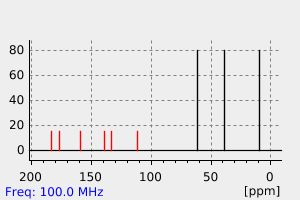含羞草霉素 | 59493-94-6
中文名称
含羞草霉素
中文别名
——
英文名称
mimosamycin
英文别名
7-methoxy-2,6-dimethyl-3,5,8(2H)isoquinolinetrione;mimosamycine;mimosamysin;7-methoxy-2,6-dimethyl-2H-isoquinoline-3,5,8-trione;7-methoxy-2,6-dimethylisoquinoline-3,5,8-trione
CAS
59493-94-6
化学式
C12H11NO4
mdl
——
分子量
233.224
InChiKey
BXQZTMMXFKFJIY-UHFFFAOYSA-N
BEILSTEIN
——
EINECS
——
-
物化性质
-
计算性质
-
ADMET
-
安全信息
-
SDS
-
制备方法与用途
-
上下游信息
-
文献信息
-
表征谱图
-
同类化合物
-
相关功能分类
-
相关结构分类
计算性质
-
辛醇/水分配系数(LogP):-0.1
-
重原子数:17
-
可旋转键数:1
-
环数:2.0
-
sp3杂化的碳原子比例:0.25
-
拓扑面积:63.7
-
氢给体数:0
-
氢受体数:4
SDS
反应信息
-
作为反应物:描述:含羞草霉素 生成 2,5-Dihydroxy-3-methoxy-4-methyl-6-prop-2-enylbenzonitrile参考文献:名称:CASTEEL, DEE ANN;PARKER, KATHLYN A., ABSTR. PAP. 194TH ACS NAT. MEET. (AMER. CHEM. SOC.), NEW ORLEANS, LA, AUG+摘要:DOI:
-
作为产物:描述:jorunnamycin A 在 4-二甲氨基吡啶 、 selenium(IV) oxide 、 对甲苯磺酸 、 silver nitrate 、 三乙胺 作用下, 以 1,4-二氧六环 、 二氯甲烷 、 水 、 乙腈 为溶剂, 反应 15.0h, 生成 含羞草霉素参考文献:名称:Chemistry of renieramycins. Part 6: Transformation of renieramycin M into jorumycin and renieramycin J including oxidative degradation products, mimosamycin, renierone, and renierol acetate摘要:The transformation of remeramycin M (1m) into renieramycin J (1j) and jorumycin (2) is presented along with the results of antiproliferative assay data. The chemical stability and the oxidative degradation of 2 and renieramycm E (1e) to generate simple isoquinoline alkaloids, such as mimosamycin (7), renierol acetate (12), and renierone (8) are also described. (C) 2004 Elsevier Ltd. All rights reserved.DOI:10.1016/j.tet.2004.02.071
文献信息
-
Synthesis of Mimosamycin作者:Bart Kesteleyn、Norbert De KimpeDOI:10.1021/jo990767d日期:2000.2.1regioselective introduction of a chloromethyl group at C-6 and a methoxycarbonylmethyl group at C-5 and subsequent reaction of the intermediate methyl (o-(chloromethyl)phenyl)acetate derivative 16 with methylamine. Oxidation of the 5,7,8-trimethoxy-2,6-dimethyl-1, 4-dihydroisoquinoline-3(2H)-one 17 thus obtained, using cerium(IV) ammonium nitrate as a selective oxidizing agent, gave mimosamycin (1) in good overall
-
Chemistry of Antitumor Isoquinoline-quinone Alkaloids: Unexpected Oxidative Degradation of Saframycin S to Generate Simple Isoquinoline Alkaloids, Mimosamycin and Mimocin作者:Naoki Saito、Yu-ichi Koizumi、Chieko Tanaka、Khanit Suwanborirux、Surattana Amnuoypol、Akinori KuboDOI:10.3987/com-03-s45日期:——Saframycin S, prepared by treating saframycin A with silver nitrate in aqueous acetonitrile, was transformed into simple isoquinolinequinones, mimosamycin and mimocin, by treatment with a catalytic amount of trifluoroacetic acid (TFA) in chloroform. The proposed mechanism for this oxidative degradation is presented.
-
Cribrostatins 1 and 2申请人:ARIZONA BOARD OF REGENTS公开号:EP0528615A1公开(公告)日:1993-02-24The blue marine sponge Cribrochalina sp., collected in the Republic of the Maldives, was found to contain the new cell growth inhibitory isoquinolinequinones designated cribrostatin 1 (8.8 x 10⁻⁶% yield) and 2 (3.1 x 10¹⁶% yield) which are active against the P388 lymphocytic leukemia cell line (PS ED₅₀ 1.58 µg/mL, PS ED₅₀ 2.73 µg/mL, respectively). Importantly, both cribrostatins 1 and 2 have shown selective activity against all of the nine human melanoma cell lines employed by the U.S. National Cancer Institute. Structural determinations of both substances were accomplished utilizing high field NMR (400 MHz) and mass spectral studies. Confirmation of the cribrostatin 1 structure was achieved by X-ray crystallographic techniques.
-
Conjugate heat shock protein-binding peptides申请人:——公开号:US20030134787A1公开(公告)日:2003-07-17The present invention relates (i) to conjugate peptides engineered to noncovalently bind to heat shock proteins; (ii) to compositions comprising such conjugate peptides, optionally bound to heat shock protein; and (iii) to methods of using such compositions to induce an immune response tin a subject in need of such treatment. It is based, at least in part, on the discovery of tethering molecules which may be used to non-covalently link antigenic peptides to heat shock proteins. The present invention also provides for methods of identifying additional tethers which may be comprised, togethter with antigenic sequences, in conjugate peptides.本发明涉及(i)工程化的与热休克蛋白非共价结合的共轭肽;(ii)包含这种共轭肽的组合物,可选择与热休克蛋白结合;以及(iii)使用这种组合物诱导需要这种治疗的受试者产生免疫反应的方法。本发明至少部分基于系链分子的发现,该分子可用于将抗原肽与热休克蛋白非共价连接。本发明还提供了鉴定其它系链的方法,这些系链可与抗原序列一起组成共轭多肽。
-
Modulation of heat-shock-protein-based immunotherapies申请人:——公开号:US20040071656A1公开(公告)日:2004-04-15Methods and compositions are provided for modulating the immune response to an antigen based upon the finding that the cell surface protein CD40 is a mammalian heat shock protein (hsp) receptor. Cell surface CD40 mediates the binding, cell signaling, and uptake of hsp and particularly hsp with antigen bound thereto. Methods are provided for modulating hsp-antigen uptake and an immune response to the antigen by altering CD40 expression, as well as utilizing CD40-binding fragments of mammalian hsp and muteins thereof for targeting antigens to CD40-expressing cells. Screening methods for agonists and antagonists of the CD40-hsp interaction are also provided.
表征谱图
-
氢谱1HNMR
-
质谱MS
-
碳谱13CNMR
-
红外IR
-
拉曼Raman
-
峰位数据
-
峰位匹配
-
表征信息
同类化合物
(4-(4-氯苯基)硫代)-10-甲基-7H-benzimidazo(2,1-A)奔驰(德)isoquinolin-7一
高氯酸9-碘-11-甲基吡啶并[1,2-b]异喹啉正离子
高唐碱
顺阿曲库胺草酸盐
顺苯磺阿曲库铵叔丁酯异构体
降氧化北美黄连次碱
阿莫伦特
阿特拉库铵杂质20
阿特拉库铵杂质19
阿特拉库铵杂质19
阿曲库铵杂质V
阿曲库铵杂质N
阿曲库铵杂质J
阿曲库铵杂质I
阿曲库铵杂质F
阿曲库铵杂质E
阿曲库铵杂质E
阿曲库铵杂质D2
阿曲库铵杂质D
阿曲库铵杂质C
阿曲库铵杂质A
阿曲库铵杂质8
阿曲库铵杂质48
阿曲库铵杂质47
阿曲库铵杂质1
阿曲库铵EP杂质D
阿曲库铵
阿曲库胺草酸盐
阿司他丁
阿区库铵去甲基杂质
长茎唐松碱
过氧荧光素1
贝马力农
衡州乌药碱; 乌药碱
蝙蝠葛碱
蝙蝠葛新林碱
蒂巴因水杨酸盐
葡萄孢镰菌素
萘酞磷
萘氨磷
萘亚胺
莲心季铵碱
莲子心碱
莫沙维林
苯酚,4-[(1,2,3,4-四氢-2-甲基-1-异喹啉基)甲基]-
苯磺顺阿曲库铵杂质23
苯磺安托肌松
苯并咪唑并[2,1-A]苯并[D,E]异奎千酮-7-酮
苯并[g]异喹啉-5,10-二酮
苯并[f]异喹啉-4(3h)-酮







